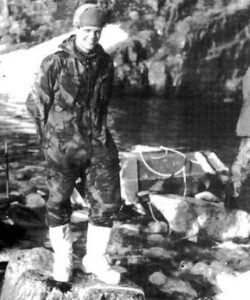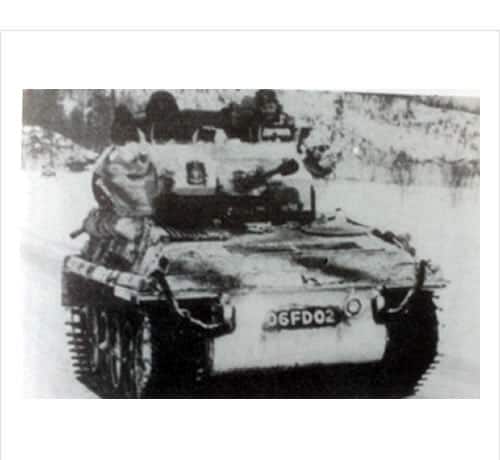Lt Coldrey, 4th Troop Leader, ‘D’ Squadron, QRIH
It was -17°C. The enemy was reported to be in a small valley in the Norwegian hinterland. The troop was ordered to deploy and report on enemy strengths and positions. Half the troop went south and the rest north with the troop leader. The perspex screens protected the faces of the drivers and commanders from the wind, which with the vehicle going at any sort of speed dropped the temperature to -40°C, because of the wind chill factor. The half troop arrived in the area that we were to search after a slow, cold and very slippery journey. We found the small mountain track that we knew led to the enemy after some difficulty because driving snow had cut visibility to a minimum.
At 0900 we made our first attempt to penetrate the valley. However, three miles was the limit of our exploitation because of treacherous road conditions; ice covered by snow. By 1100 hrs the weather had improved. The sun was out and the temperature rose to 10°C. The thaw was on, the snow turning to slush, and the river beginning to flow with zest.
Again we attempted to push on up the pass! I took my section and drove up to the tunnel stopping just above it, and just below the strip of track that had halted our advance earlier in the day. Tpr Gavin, my driver, LCpl North, my operator and I dismounted to check the road conditions. The track looked much better. Finally, the balance was tipped in favour of attempting another advance by a VW Beetle that shot up the road without chains on.

My thoughts were that the Scimitar was capable of going anywhere a car could; not an unreasonable deduction considering its cross country ability. For extra precaution, I told the driver to reverse up the road so that we would have better traction and in the event of wishing to go back we would not have any problems trying to return down the track in reverse. ‘Dungiven’ made light work of the first 600 metres, however, on the final turn into the top tunnel the vehicle lost traction and began to slide back. Gavin applied the brakes, but she continued to slide sideways down the track. Initially, I thought she was going to stop but suddenly she began to pick up speed. The driver tried to straighten her. ‘Dungiven’ hit the small sidewall of the road, but instead of bouncing off it, she mounted it. There was a small strip of snow, about 5 meters, between the vehicle and a yawning chasm of eternity.
The decision had to be made. Save the vehicle and risk the crew or save the crew. The vehicle may have been turned on the snow because this would have given better traction, but the chances I estimated were about 50% in our favour 50% against. I ordered the driver and gunner to “Bale Out”. LCpl North hit the ground before I’d said out! St. Christopher had obviously been watching over Tpr Gavin that day. By some quirk of fate, not 10 minutes before the accident, the gunner while traversing had broken Gavin’s wind-screen off. This made the difference between life and death, between being able to get out of the vehicle and not.
In situations like this everything seems to move so slowly, and the time taken from the initial loss of control to the end could only have been 5 seconds. Certainly, they were the longest 5 seconds in our lives. My last recollection of ‘Dungiven’ was the rear lights as she flipped over the edge into the gorge below, and of Tpr, Gavin flying ‘Superman’ fashion through the air. Few champagne corks come out of their bottles with the explosive speed displayed by Tpr Gavin. Perhaps he will show it again someday!
On picking ourselves up one of the crew mumbled about the FMT 3 and we promptly burst into laughter, the tension was released and we could now operate without any fear of initial shock. Funnily enough, the man who showed most signs of shock was the operator of my other section vehicle who could not believe that we had lost a vehicle and had to go and look himself. He was sure that we had parked it around the corner or up in the tunnel and were pulling his leg. It was not until he actually saw where the vehicle went over that he realised it was not a joke.
There then followed a short report to the enemy commander who was running the Exercise which went something like this:
‘Hello, 149 this is T64A No Duff Over’.
‘149 send over’.
‘T64A this is Sunray C/S T64A, No Duff. T64’s vehicle has fallen over a cliff and we can’t find it. It is believed to be in a pool under a waterfall. There was no loss of life. No Duff Over’.
‘149 You’re pulling my leg’.
‘T64A No Duff correct over’.
‘149 er . . . um . . . roger out’.
5 minutes later.
‘Hello T64A this is . . . your not pulling my leg are you over’.
‘T64A No over’.
‘149 roger wait out’.
2 minutes later a Snow-Cat appeared with many more aghast faces.
At this stage, I was flown with my crew to base camp. The next morning we joined the guard on the valley to exclude any unauthorised personnel from pilfering useful items or War Office Controlled stores. On arrival, I was shown by Tpr Smith to a barn that SSgt Lawley had taken over. Over the door was a sign ‘Welcome to the Flying Scimitar Club’. President Lt Coldrey, Flying Instructor Tpr Gavin. So began the efforts to recover 06FD22.
A diving team was brought in and they assessed the damage, no road wheels or final drive one side, no tracks, turret detached and 15 meters from the hull, all sights shattered, 30mm cannon snapped in two, turret interior collapsed, hull, engine end, stoved in. The 165 ft fall had done considerable damage, and there was little doubt in anyone’s mind that all the crew members would have died had they gone over the edge.
A small amusing article found by the frogmen in the effort to recover as much of value as possible was a pair of black crutch-less knickers. They appeared like ‘Excalibur’ from the pool in the black upthrust hand of the diver. The guilty owner was never found!
The guard of the site was done by the Snowcat and one Scimitar. 3 men sleeping, 2 men running the ‘II sight’ and radio. While we were preparing for bed one evening there were several rockfalls all around us. LCpl Morrison was heard asking me if it was safe or not. The answer was that if the freeze-thaw process continued it might be dangerous. Just as LCpl Morrison was going to sleep I gave Sgt Hooper the nod and reached up and slammed my hand into the roof of the vehicle. LCpl Morrison established the record for the ‘green maggot’ long jump. Encapsulated in his sleeping bag he shot out of the vehicle in utter panic and under the Scimitar to roars of uncontrollable laughter.
By the 3rd day of the recovery operation, it was obvious that things were not going to plan, the thaw had begun in earnest and the river which on the day of the accident was a mere trickle had now become a gushing river 10 meters wide, and continual rock falls made working conditions down at the pool precarious at best. The recovery vehicle had to be withdrawn from the river bed below the pool for fear of losing that as well.
On 15th February 1982, seven days after the accident it was decided that the cost of recovery was not worth the end result. So having pulled the turret to the bank the engineers began to pack the vehicle with PE. SSgt Lawley was seen at this stage with a sledgehammer emulating Thor and trying to hack the right sight out — Maniac!
At 1502hrs with the valley clear, I pressed the red button and ‘Dungiven’ died.
R 171600Z FEB 82
FW SW DIST CON CELL
TO UKLF
INFO: QRIH
Ex Hardfall. Recovery of CVR(T) 06FD22. Connect our SIC BAA DTG 10 1800Z FEB 82. Further Sitrep.
Recovery is now complete. All weapons, Radios, Sights and loose items were accounted for. List contained in report sent by post to UKLF, SW DIST, QRIH and BRITMILAT.
Hull and Turret demolished by explosive. Remnants submerged underwater. Debris cleared. HN satisfied.
Board of Inquiry convened to take place in Feb 82.
Suggest 06FD22 is struck off veh census.
QRIH Journal 1983


